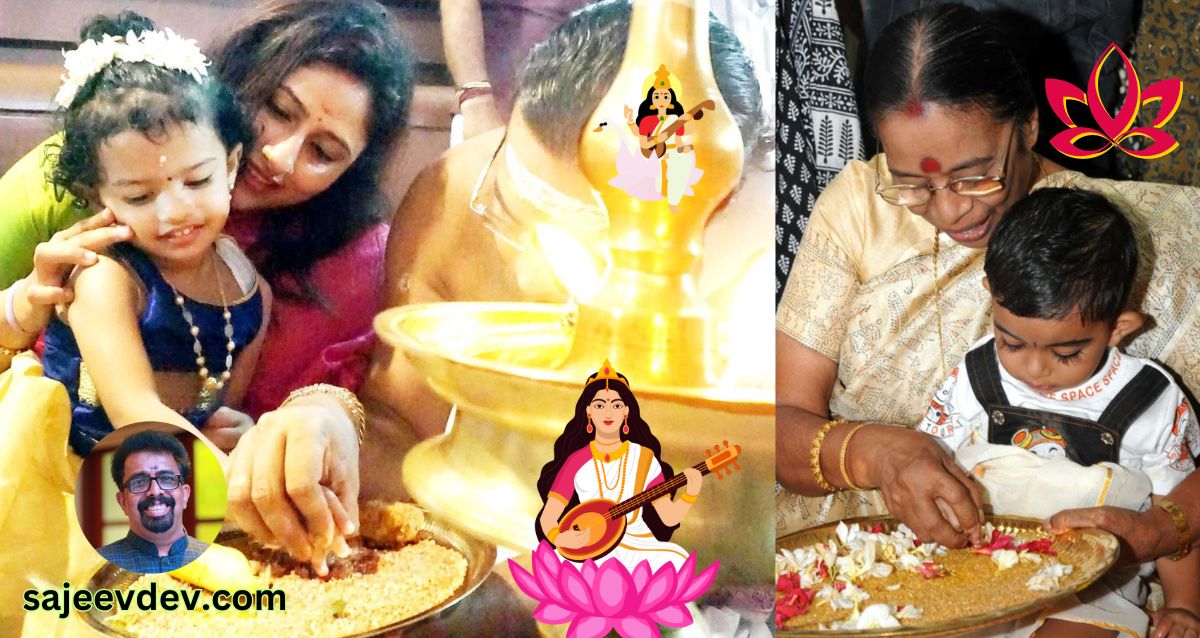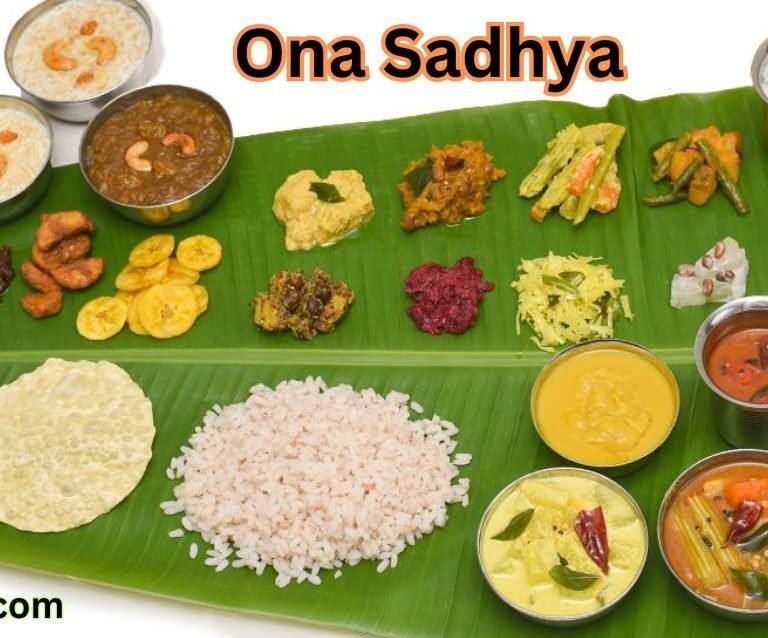Vidyarambham, a significant ceremony in Hindu culture, serves as a formal initiation into the world of learning for children
Vidyarambham, a significant ceremony in Hindu culture, serves as a formal initiation into the world of learning for children. The term itself derives from Sanskrit, where “Vidya” translates to “knowledge” or “learning,” and “Arambham” means “beginning” or “commencement.” Thus, Vidyarambham can be understood as the “beginning of knowledge,” symbolizing an auspicious start to a child’s educational journey. This ceremony is celebrated predominantly in various parts of India, with notable practice in South Indian states and among certain communities.
Synonyms for Vidyarambham include Akshara Abhyasam in Telugu culture, which can be translated as “initiation of letters,” and Mutal Eluttu in Tamil. These terms encapsulate the essence of the ceremony, emphasizing its focus on introducing letters and writing as foundational skills in a child’s education. The overarching theme in all these names reflects the transitioning from a state of innocence to one of learning, where children are formally engaged in their academic pursuits.
Vidyarambham is typically conducted when children are around the age of five. It is often marked by a ceremonial gathering where parents and elders bless the child and partake in the ritual of writing the first letters or syllables on a tray of rice or sand. This traditional practice not only signifies the child’s entry into formal education but also embodies cultural values associated with learning and knowledge in Hindu philosophy. The ceremony is a revered event, attended by family members and sometimes community members, highlighting the collective emphasis on the importance of education in shaping an individual’s future.
Etymology of Vidyarambham
The term “Vidyarambham” is derived from two significant Sanskrit components: “Vidya” and “Arambham.” Understanding these linguistic roots offers valuable insight into the purpose and cultural significance of this Hindu initiation ceremony of learning. “Vidya,” which translates to knowledge or wisdom, represents a core value in Hindu philosophy. In this context, knowledge encompasses not only formal education but also the wisdom inherent in spiritual and moral teachings. It reflects the Hindu belief in the divine nature of knowledge and its essential role in personal and communal development.
The second component, “Arambham,” translates to beginning or commencement. This term signifies not merely the starting point of education but a pivotal transition in an individual’s life, marking the initiation into a world of learning and inquiry. The combination of these two words – Vidya and Arambham – encapsulates the essence of the ceremony, which is to celebrate the beginning of a child’s formal education journey. This transition is believed to imbue the child’s pursuit of knowledge with divine blessings, emphasizing the sacredness of the learning process.
In Hindu culture, these concepts are not isolated; instead, they reflect a broader commitment to lifelong learning, education, and the pursuit of wisdom. By initiating children into learning through Vidyarambham, families express their hopes for their children’s futures, emphasizing a strong foundation in ethics, culture, and academics. Thus, the etymology of Vidyarambham serves not only to elucidate the meaning of the ceremony but also to highlight the underlying values that shape the rituals and beliefs surrounding education in Hindu tradition.
Ceremony Description
Vidyarambham is a significant Hindu initiation ceremony wherein children are introduced to the world of learning. Typically performed when a child is around the age of three, this ritual takes place on the auspicious day of Vijayadashami, which marks the conclusion of the Durga Puja festival. Vijayadashami symbolizes the triumph of good over evil and is considered a propitious time to commence a child’s education.
The ceremony is primarily led by a parent or an educator, who plays a pivotal role in guiding the child through the rituals. The atmosphere during Vidyarambham is one filled with excitement and reverence, as families gather to celebrate this milestone. The parent, often the father or a close elder, holds the child in their lap and helps them write the first letters of the alphabet in a tray filled with grains, typically rice or wheat. This act of writing is not merely a mechanical process but is imbued with deep, symbolic significance, representing the initiation of knowledge and wisdom.
As part of the ceremony, mantras and sacred scriptures are recited, invoking blessings for the child’s future. This aspect highlights the spiritual essence of Vidyarambham, emphasizing that the pursuit of knowledge is a sacred duty. It serves as a reminder that education transcends mere academics and cultivates moral and ethical values. The writing in grains symbolizes the soft beginning of education, allowing the child to engage with learning in a playful yet meaningful manner. Furthermore, this process fosters a familial bond, with the parent actively participating in the educational journey of their child.
Through Vidyarambham, children are inspired to embrace the joys of learning and recognize the importance of education as they embark on their academic endeavors. The ceremony, steeped in tradition, stands as a beautiful initiation into the lifelong pursuit of knowledge.
Significance of Vidyarambham
Vidyarambham, the Hindu initiation ceremony of learning, holds profound cultural significance as it marks a child’s first steps into the world of knowledge and education. This ritual is particularly associated with the worship of Goddess Saraswati, the embodiment of wisdom, learning, and the arts. To many Hindus, invoking her blessings during Vidyarambham is seen as essential for attaining clarity in thought and excellence in learning. The ceremony generally takes place on Vijayadashami, a day celebrated with great reverence, emphasizing the auspiciousness and the spiritual connotations tied to the occasion.
The timing of Vidyarambham aligns perfectly with Vijayadashami, which is not only a symbol of victory over ignorance but also a celebration of knowledge and virtues. This auspicious day, often associated with the victory of good over evil, acts as a favorable backdrop for new beginnings, particularly in education. The tradition of initiating learning during this period underscores the belief that beginning educational endeavors under the watchful eyes of the divine leads to successful outcomes in one’s academic pursuits.
Moreover, Vidyarambham is closely related to the rituals of Ayudha Puja, where tools of the trade and instruments used for education are revered and blessed. This practice highlights the value placed on learning instruments, whether they are books, pens, or other educational materials. Additionally, the ceremony fosters respect toward teachers through Gurudakshina, a tradition of showing gratitude and offering respect to educators. This act not only honors the teacher’s role but also emphasizes the importance of guidance in the learning process. Therefore, Vidyarambham serves as a vital cultural rite, integrating spiritual beliefs with educational aspirations, enriching the values of respect, devotion, and commitment to learning in the community.
Regional Practices and Variations
Vidyarambham, a significant Hindu initiation ceremony marking the beginning of a child’s education, exhibits distinct practices and variations across different South Indian states, such as Kerala, Karnataka, Tamil Nadu, Andhra Pradesh, and Telangana. Each region’s customs are deeply influenced by local traditions, rituals, and symbolic elements that enrich the ceremony’s cultural context.
In Kerala, Vidyarambham is celebrated with great fervor, often coinciding with the festival of Vijayadashami. Families gather at temples and homes, where a learned individual, typically a priest or a respected elder, guides the child to write the first letters on a plate of rice or in a tray filled with flour. The use of music and dance, particularly through traditional art forms like Kathakali, adds a unique vibrancy to the celebration, creating an inviting atmosphere for learning.
Conversely, in Karnataka, the ceremony may also involve writing on a plate of rice but can include additional rituals such as the application of sacred ash (vibhuti) on the child’s forehead. This act symbolizes purity and knowledge. In urban areas, the event may take on a modern twist, incorporating educational tools like books and digital devices into the ceremony, reflecting the evolving nature of education.
Tamil Nadu retains rich traditions during Vidyarambham, often intertwining it with other auspicious occasions. The ceremony typically includes singing devotional songs and reciting prayers, embodying the region’s reverence for learning. Children may hold small idols of Saraswati, the goddess of knowledge, invoking her blessings before embarking on their educational journey.
In Andhra Pradesh and Telangana, Vidyarambham is similarly celebrated with rituals that emphasize the significance of education. Families may involve local deities, offering prayers and food items to seek divine blessings. Overall, while the core essence of Vidyarambham remains the same, its regional adaptations showcase the diverse cultural tapestry of South India, highlighting the local customs and symbols integral to this cherished celebration.
Vidyarambham in Other Indian Cultures
The Vidyarambham ceremony, primarily observed in Kerala, has foundational roots in the broader Indian cultural tapestry, wherein diverse states exhibit their unique adaptations of this rite of passage. One notable variation is the Khadi Chuan ceremony prevalent in Odisha. This event symbolizes the initiation of children into the world of learning and knowledge, akin to Vidyarambham, although it carries distinctive regional traditions and significance. In Odisha, families engage in this ritual with enthusiasm, often celebrated with local customs that include the recitation of prayers and the performance of symbolic rituals that emphasize the importance of education.
The Khadi Chuan usually takes place during auspicious days, which parents consider particularly favorable for initiating their children into literacy. This adaptation reflects not only the understanding of education within the Odia community but also signifies a heartfelt commitment to upholding cultural customs tied to learning. Moreover, the involvement of community and family during these celebrations highlights the collective importance of education in Indian society as a whole.
Additionally, temples play a crucial role in hosting these initiation ceremonies. The Gnana Saraswati temple in Basar, Telangana, is one of the popular sites where Vidyarambham rituals are conducted. As a center of knowledge and learning, this temple attracts numerous families seeking blessings for their children before they embark on their educational journeys. Various temples across India also embrace the essence of Vidyarambham in their activities, thus reinforcing the spiritual and cultural dimensions of education throughout the nation.
These varying practices of the Vidyarambham ceremony reiterate the shared reverence for education found across different Indian cultures, showcasing how regional customs coalesce around a universal value—promoting knowledge and wisdom among the younger generations.
The Role of Parents and Gurus
The Vidyarambham ceremony, which marks the initiation of learning in the Hindu tradition, highlights the significant role that parents and gurus play in a child’s educational journey. During this sacred event, it is imperative for parents to offer their support and encouragement, as they stand as the first teachers in a child’s life. Their involvement in the ceremony not only signifies their commitment to their child’s education but also symbolizes the transmission of cultural and spiritual values. This initial step into learning is enriched by the parents’ guidance and their active participation in the rituals, ensuring that the child understands the importance of both learning and the respect due to knowledge.
Equally crucial are the gurus, or teachers, who take on the responsibility of nurturing the child’s intellect and moral compass. The presence of a guru during the Vidyarambham ceremony serves as an affirmation of the spiritual and educational lineage to which the child is being introduced. The guru, often regarded as a spiritual guide, imparts the first lessons of knowledge through the symbolic writing of letters in rice or sand, a beautiful gesture representing the beginning of formal education. This act emphasizes the profound respect and reverence bestowed upon teachers in Hindu culture.
Additionally, the offering of symbolic items, such as Betel leaves, plays a vital role in this initiation ceremony. These items are often presented as a form of Gurudakshina, an offering made to the guru in gratitude for their teachings. By participating in these rituals, parents and gurus reinforce the significance of education within the cultural context and establish foundational values for the child. Thus, their roles in the Vidyarambham ceremony are paramount, as they collectively foster an environment where knowledge is revered and the child’s intellectual pursuits are inspired.
Modern Interpretations and Celebrations
In contemporary societies, Vidyarambham has evolved significantly while retaining its core essence as a celebration of learning. Families and communities across India now engage in diverse interpretations that reflect modern educational paradigms, showcasing a dynamic integration of tradition and innovation. Increasingly, this ceremony is being adapted to align with contemporary education systems, recognizing the shift from traditional learning environments to digital platforms.
One notable trend is the incorporation of technology within the ceremony. Families are utilizing online platforms and applications to facilitate the learning process, allowing children to engage in educational activities digitally. This shift not only makes learning more accessible but also helps families to create a blend of the ceremonial aspects of Vidyarambham with modern learning techniques. Many parents use social media to document these celebrations, sharing videos and photographs that highlight their children’s first steps in learning to write or recite verses, thus extending the spirit of Vidyarambham beyond the confines of traditional rituals.
Moreover, community observances are gaining prominence as well. Local organizations and educational institutions now hold events that celebrate this important occasion, often including workshops, storytelling sessions, and competitions that encourage collective participation. Such gatherings foster a sense of community and reinforce cultural bonds while simultaneously emphasizing the value of education in the lives of children. This approach resonates particularly well with younger generations, who appreciate the communal aspect of learning.
As Vidyarambham continues to be celebrated in modern contexts, families remain committed to honoring its cultural roots. Whether through traditional practices or contemporary interpretations, the essence of this initiation ceremony of learning persists, bridging the gap between age-old customs and modern realities. This balance ensures that Vidyarambham remains a relevant and cherished tradition for generations to come.
Vidyarambham represents more than just an initiation ceremony; it encapsulates a rich cultural tradition that plays a crucial role in the Hindu educational landscape
Vidyarambham represents more than just an initiation ceremony; it encapsulates a rich cultural tradition that plays a crucial role in the Hindu educational landscape. This ceremony, typically conducted in the presence of family members, signifies the commencement of formal learning for young children, marking the transition from the innocence of early childhood into the more structured world of scholarship. It is an event steeped in symbolism, holding immense significance in the lives of those who partake in it. The rituals associated with Vidyarambham serve to instill respect for knowledge and embody the belief that education is a sacred pursuit.
This event also highlights the importance of reverence towards teachers, who are often viewed as guiding lights in the educational journey. The act of beginning one’s learning journey with the blessings of a teacher is a profound gesture that acknowledges the invaluable role they play in shaping character and intellect. The ceremony fosters a sense of gratitude and recognition for the wisdom imparted by educators, promoting a lifelong love and respect for learning.
Moreover, Vidyarambham emphasizes the celebration of knowledge across various aspects of life. It suggests that learning is not confined to the walls of educational institutions but is a continuous journey that permeates all dimensions of existence. The values instilled during this ceremony encourage individuals to embrace learning in its myriad forms, whether it be through formal studies, personal endeavors, or experiential knowledge acquired through life lessons.
In light of these insights, it is clear that Vidyarambham is emblematic of the enduring cultural values that uphold education, respect, and appreciation for wisdom. As individuals and families continue to honor this tradition, they not only keep alive the customs of the past but also lay the foundation for a future built on the principles of learning and respect.







